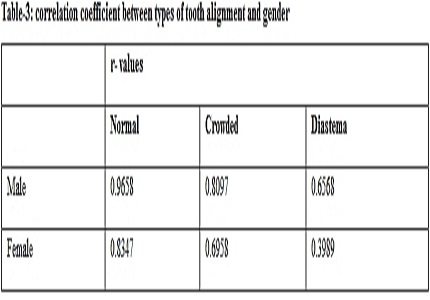Stature estimation and its reliability in different types of dental alignment using the Carrea’s Index
Abstract
Introduction: Estimation of stature holds a special place in the field of forensic medicine.
Objectives: This study was designed to investigate the ability of estimating stature from the dimensions of lower anterior teeth.
Method: The study was carried out by taking the measurement from the mesio-distal widths of lower central incisor, lateral incisor and canine of 100 undergraduate students for examination. Each hemiarch was considered separately equaling 200 inferior hemi-arches, which were divided according to the dental alignment into normal, crowded and diastema and the measurements (arch and chord) were made with a ‘divider caliper’.
Result: A statistically significant difference between the types of dental arch was obtained for both males and females with regards to the different dental alignments; higher correlation between stature the arch for normal alignment (r=0.9658; r =0.8347); moderate correlation for crowded alignment (r=0.8097; r =0.6958); and a weaker correlation for diastema (r = 0.656, r = 0.3938) for male & female respectively. The left side of the hemiarch showed a higher success rate (82%) in comparison to right side (72%). Statistically significant differences were also found between the types of arches for both right and left side (p<0.005).
Conclusion: The present study would be useful for stature estimation to the forensic experts.
Downloads
References
2. Lima LNC, Neves GLS, Rabello PM. Carrea’s index in dental students at the Federal University of Paraíba. Braz J Oral Sci 2008; 7:1673-1677.
3. Tinoco RL, Martins EC, Daruge E Jr, Daruge E, Prado FB, Caria PH. Dental anomalies and their value in human identification: a case report. J Forensic Odontostomatol. 2010 Dec 1;28(1):39-43. [PubMed]
4. Carrea JU. Talla individual human enfunción al radio cuerda. Ortodoncia 1939; 6:225-227.
5. Silva MA, Sakaguti A,Carrea`S'methodapplicationto Estimate stature In Individuals Using Teeth Measures In Brazilian population. Journal of Research in Dentistry, Tubarão, v.2, n. 4, 2014, P-298-306.
6. Stedman TL. Stedman’s dictionary, Baltimore. Lippencott Williams and Wilkins; 2000.
7. Krishan K.Estimation of stature from footprint and foot out line dimensions in Gujjars of North Forensic Sci Int. 2008 Mar 5;175(2-3):93-101. Epub 2007 Jun 25. [PubMed]
8. Jason DR, Taylor K. Estimation of stature from the length of the cervical, thoracic, and lumbar segments of the spine in American whites and blacks. J Forensic Sci. 1995 Jan;40(1):59-62. [PubMed]
9. Holland TD. Estimation of adult stature from fragmentary tibias. J Forensic Sci. 1992 Sep;37(5):1223-9. [PubMed]
10. Boldsen J. A statisticalevaluation of the basis for predictingstature from lengths of longbones in Europeanpopulations. Am J Phys Anthropol. 1984 Nov;65(3):305-11. [PubMed]
11. Oliveira RN, Daruge E, Galvão LCC, Tumang AJ. Collaboration of forensic odontology for identification postmortem. Rev Bras Odontol 1998; 55: 117-122. [PubMed]
12. Brkić H, Keros J, Kaić Z, Cadez J. Hereditary and environmental dental findings in identification of human remains. Coll Antropol. 2000 Jul;24 Suppl 1:79-83. [PubMed]
13. Cavalcanti AL, Porto DE, Maia AMA, Melo TRNB. Estimativa da estaturautilizando a análisedentária: estudocomparativo entre o método de Carrea e ométodomodificado. Rev Odontol UNESP2007;36(4):335-339
14. Prabhu S, Acharya AB, Muddapur MV. Are teeth useful in estimating stature? J Forensic Leg Med. 2013 Jul;20(5):460-4. doi: 10.1016/j.jflm.2013.02.004. Epub 2013 Feb 28.



 OAI - Open Archives Initiative
OAI - Open Archives Initiative


